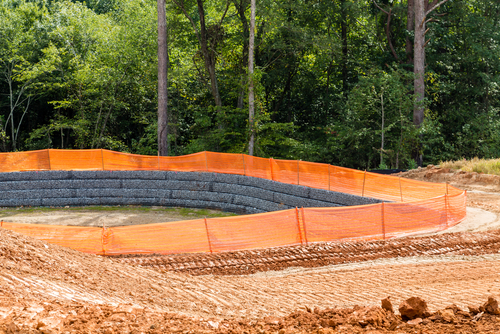Sediment control using tanks or silt ponds on construction sites
What you must do
 Settlement tanks remove suspended solids like silt from water.
Settlement tanks remove suspended solids like silt from water.
Effective removal of solids
In order to work, the flow of water through a water settlement tank must slow down sufficiently for suspended solids to settle out.
To achieve this, the settlement facility must be the correct size for the volume of water that will flow through it and the size of the particles suspended within it. The smaller the particle sizes, the longer they will take to settle out.
The greater the volume of water that you anticipate, the larger the capacity of the lagoon required.
CIRIA have produced a document called 'Control of Water Pollution from Construction Sites - Guidance for consultants and contractors' (2001) which outlines methods of water control including retention time calculations for settlement lagoons.
CIRIA: Control of water from construction sites
Information can also be found in GPP 6 Working at construction and demolition sites
If the particle size is very small or light and will not settle out, another option could be to dose the water with chemicals called flocculants. These make the solid particles bind together and encourage them to settle out. Flocculants are not suitable for all locations and can cause pollution if not used correctly. You must speak to your environmental regulator before you consider using flocculants.
Contact your environmental regulator
Potential pollutants
Water that enters settlement tanks from certain processes may contain pollutants in addition to suspended solids. A settlement tank will not remove these pollutants before the water is discharged. You may therefore need to consider treatment options.
For example, mechanical failure during tunnelling operations may result in high levels of hydraulic oil being present in water discharged to settlement lagoons.
When you design a settlement lagoon, ensure that discharge from the lagoon can be stopped and contaminated water contained if necessary.
Oil can be removed from settlement lagoons by installing an interceptor, by using a skimmer to remove the oil from the surface of the water or by containing the oil with absorbent pads and booms.
You must dispose of absorbent pads, oil removed by a skimmer or other waste materials that contain hydrocarbons as hazardous/special waste.
Authorisation for discharge from your settlement tank or lagoon
You must not make any discharge to surface water or groundwater without consulting your environmental regulator. If you discharge without an authorisation, permit or consent from your environmental regulator you could be prosecuted and fined or imprisoned.
You must not discharge trade effluent to a public sewer without trade effluent consent or a trade effluent agreement with your water and sewerage company or authority. If you discharge without a consent or agreement you could be prosecuted and fined or imprisoned.
Trade effluent - managing liquid wastes
